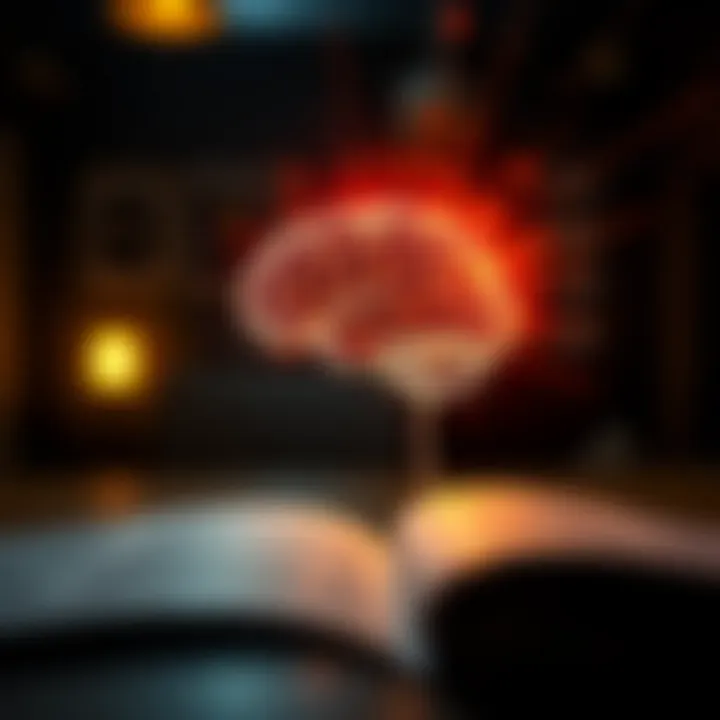Deep Dive into Thinking, Fast and Slow


Intro
In the realm of understanding how we think, Daniel Kahneman’s work 'Thinking, Fast and Slow' serves as a guiding lighthouse, illuminating the intricate pathways of human decision-making. Kahneman’s deep dive into cognitive psychology unveils two distinct modes of thinking—one that is rapid and instinctive, the other slow and more deliberate. This exploration doesn't just scratch the surface; it penetrates the core of how biases and heuristics shape our lives, offering insights that are pivotal for anyone looking to elevate their decision-making, whether in business, education, or personal spheres.
The relevance of Kahneman's ideas resonates across various fields, encouraging us to reflect on the interplay between our intuitive choices and more calculated ones. By dissecting his findings, readers are primed to grasp not just the theoretical underpinnings but also the real-world implications of this profound duality in thinking.
Prologue to Dual-Process Theory
Understanding how we think is pivotal in grasping the nuances of decision-making. Daniel Kahneman’s exploration of dual-process theory reveals two distinct systems that shape our thoughts. This framework of System One and System Two provides clarity on why we sometimes make snap judgments, while other times, we engage in lengthy deliberations. The significance of delving into this theory lies not just in academic interest; it paves the way for practical applications in everyday life and various professional fields.
The primary benefit of looking into dual-process theory is that it highlights the cognitive mechanisms behind our decisions. System One, often described as rapid and intuitive, is our mental shortcut that allows us to react quickly to stimuli without extensive thought. Examples abound in daily life—from how quickly we can tell if someone is trustworthy based on a first impression, to our gut reactions in familiar situations. This system is crucial for functioning efficiently in a fast-paced world.
In contrast, System Two takes a more measured approach, engaging in deeper analysis and rational thinking. It’s where we undertake complex calculations, evaluate different perspectives before making significant choices, or solve intricate problems. Recognizing when to engage each system is vital for improved decision-making and can significantly impact personal and professional outcomes.
By unpacking these concepts, readers can identify their mental patterns and potentially mitigate biases that arise from relying too heavily on one system. Thus, the importance of dual-process theory extends beyond mere analysis; it becomes a toolkit for enhancing self-awareness and decision quality in various contexts.
"The ability to recognize which system we are using in a given moment can empower us to make better choices, ultimately improving our lives."
Engaging with this dual-process perspective isn’t just theoretical—it's deeply practical. Whether for students, educators, or business leaders, these insights form a vital part of understanding human behavior, communication, and even conflict resolution. In an age that increasingly values emotional intelligence and analytical skills, recognizing the balance between intuition and rational analysis becomes invaluable.
Cognitive Biases and Their Impact
Cognitive biases play a fundamental role in shaping our decision-making processes. These mental shortcuts often assist us in quickly processing information, but they can also lead us down misleading paths. Understanding the influence of these biases is crucial for anyone seeking to enhance their decision-making abilities, whether in personal life or in a professional context. By acknowledging cognitive biases, individuals can improve their critical thinking skills and make more informed choices.
When we grapple with decisions, cognitive biases act like an invisible hand, guiding our judgments in sometimes detrimental ways. For instance, these biases shape our perceptions and often dictate how we interpret circumstances. Recognizing these effects not only promotes self-awareness but also allows us to navigate through complex situations more effectively.
Anchoring Effect Explained
The anchoring effect serves as a poignant example of a cognitive bias where initial information heavily influences our subsequent decisions. For instance, consider a situation where you're shopping for a car. If the first car you see is priced at $50,000, any subsequent options might seem cheaper or more reasonable in comparison, even if they are still outside your budget. This tendency to rely heavily on the first piece of information encountered can distort our reasoning and affect our final choices.
In practice, the anchoring effect manifests in various scenarios, from sales tactics in retail to negotiations in a corporate setting. Often, marketers will price a product higher initially to make any discounts appear more appealing. This strategy effectively relies on the anchoring effect to sway consumer behavior, capitalizing on our propensity to fixate on initial information.
Availability Heuristic
Next up is the availability heuristic, which suggests that individuals often evaluate the probability of events based on how quickly they can recall instances of those events from memory. If you've recently read news stories about airplane crashes, you might believe that flying is far riskier than it is in reality. This cognitive bias leads you to overlook the actual statistics favoring air travel.
The availability heuristic affects not only personal choices but also broader societal conversations. For instance, media coverage of certain issues can skew public perception, making certain dangers seem more immediate than they truly are. Understanding this bias pushes individuals to consider broader data rather than relying solely on vivid or memorable events.
Confirmation Bias in Decision Making
Finally, we come to confirmation bias, a powerful cognitive distortion wherein individuals favor information that confirms their preexisting beliefs while dismissing contradicting evidence. This bias can profoundly affect decision-making, as individuals might selectively seek data that validates their standpoint, thereby reinforcing their misconceptions.
In an environment filled with diverse perspectives, confirmation bias can lead to groupthink, limiting critical discussions and inhibiting innovative thinking. Awareness of this bias is crucial, as it urges people to actively seek out opposing viewpoints and challenge their assumptions. By doing so, they can make more balanced and objective decisions.
Being mindful of cognitive biases opens doors to more profound insights and better decision-making strategies. \n
The Role of Intuition in Our Decisions
Intuition plays a pivotal role in how we navigate our daily choices. It acts as a quick, internal guide that usually operates under the radar of our conscious mind. In the context of Daniel Kahneman’s theories, intuition is often linked to System One thinking—fast, automatic, and often emotional. This system tends to kick in when time is of the essence or when we need to make snap judgments. Intuition can save us in situations demanding swift decision-making, but it can also lead us astray when we rely on gut feelings alone. Understanding the balance between intuition and rational thought becomes crucial in various aspects of life, particularly in personal and professional contexts.
When Intuition Works
Intuition is indispensable when it functions properly. Consider the experienced chess player who can assess a complex board position in just seconds. This player isn’t consciously analyzing every possible move. Instead, they are drawing on a wealth of past experiences that inform their decisions.
Here are instances when intuition proves effective:
- Expertise: Specialists often access their intuitive knowledge base, relying on years of practice. For example, a seasoned firefighter can assess the dangers in a burning building and make life-saving decisions rapidly.
- Recognizing Patterns: Sometimes, we make accurate predictions without knowing why. A teacher may sense a student is struggling because they’ve seen similar behaviors in other students before.
- Emotional Guidance: Intuition can help us navigate interpersonal relationships. If we feel uneasy in a social situation, there’s often a reason behind it, even if we can’t articulate what that reason is.


Intuition is like a whisper; sometimes you just have to listen closely.
When Intuition Fails
While intuition can be a valuable asset, it’s not foolproof. Many times, instinct can lead us astray, particularly when subjected to biases or misinformation. For example, someone may develop a gut feeling about a prospective employee based on their appearance, ignoring other critical factors like skills or experience.
Here are scenarios where intuition may falter:
- Overconfidence: Sometimes, intuition leads to inflated confidence. A seasoned investor may feel sure about a hotspot stock solely based on a gut feeling rather than extensive market analysis, leading to losses.
- Stereotypes: Intuition often operates using mental shortcuts. This can result in prejudices that skew decision-making. For instance, a manager might overlook qualified candidates due to an unexamined bias towards a particular school or demographic.
- Stress and Emotion: In high-stress situations, emotions can cloud judgment. A manager fired up over a project might make impulsive decisions that jeopardize team dynamics or project timelines.
Balancing intuitive and rational thinking is essential. Utilizing a dual approach can bolster decision-making, ensuring that fast judgments are informed by sound principles, ultimately bridging the gap between instinct and reason.
The Importance of Rational Thinking
Rational thinking plays a crucial role in navigating the intricacies of decision-making, particularly as highlighted in Daniel Kahneman's work. In a world where information is abundant and decisions must be made swiftly, relying solely on intuition can lead to pitfalls. Understanding the importance of rational thinking allows individuals to sift through cognitive biases that cloud judgment.
Engaging System Two, the analytical part of our brain, fosters a methodical approach to decision-making. By doing so, one can critically evaluate the options at hand and mitigate the influence of inherent biases. Rational thought does not merely push intuition aside; rather, it complements it by providing a solid foundation for choices grounded in logic and evidence. This balance can lead to more informed outcomes in both personal and professional realms.
Moreover, cultivating rational thinking equips individuals with tools to better navigate complex situations. It encourages:
- Analytical Skills: Enhances problem-solving capabilities.
- Sound Decision-Making: Promotes choices based on facts rather than whims.
- Informed Risk Assessment: Evaluates potential consequences more effectively.
- Strategic Planning: Facilitates long-term thinking that minimizes impulsivity.
By engaging in rational thought, one often finds clarity in chaotic situations, offering a refreshing perspective that simply isn't visible through instinct alone. As Kahneman illustrates, harnessing the power of rationality invites a deeper understanding of one's cognitive processes, fostering personal growth and improving decision outcomes.
Strategies for Engaging System Two
To tap into the full potential of System Two, a few targeted strategies can be adopted:
- Pause Before Acting: Taking a moment to consider pros and cons can avert rash decisions.
- Seek Diverse Perspectives: Engaging with different viewpoints can unveil biases and blind spots.
- Utilize Data: Relying on empirical evidence can ground decisions in reality rather than opinion.
- Practice Reflective Thinking: Regular introspection fosters a habit of questioning one’s initial judgments, leading to more thoughtful choices.
Implementing these practices can significantly enhance the quality of one’s decision-making.
Challenges in Rational Thought
Despite its advantages, engaging in rational thinking is not without its challenges. Some common hurdles include:
- Cognitive Overload: The sheer volume of information can be overwhelming, leading to analysis paralysis.
- Emotional Intrusions: Emotions can distort objectivity, making it hard to think clearly.
- Time Constraints: In a fast-paced world, taking the necessary time to engage System Two can be seen as impractical.
- Resistance to Change: Updating beliefs in the face of new evidence may mean admitting past errors, which can be uncomfortable.
It’s essential to recognize these obstacles and actively work to overcome them.
Expertise and Intuition
Understanding how expertise intersects with intuition is paramount in decision-making, as explored within Daniel Kahneman's work. The blend of knowledge and instinct shapes outcomes in a myriad of contexts—from business to everyday life. Recognizing how these elements function is not just for honing skills; it's an essential element in mastering the art of sound judgment.
When individuals cultivate expertise, they don’t merely accumulate facts; they weave those facts into a rich tapestry of experience. This transformation enables one to make quicker decisions when faced with uncertainty, often relying on gut feelings honed over years of practice. However, it’s crucial to remember that intuition can be a double-edged sword; it can lead to remarkable insights or catastrophic errors, depending on the circumstances.
The Role of Knowledge in Expert Decision Making
Knowledge plays a vital role in expert decision-making. When seasoned professionals tackle intricate challenges, they often tap into their rich repository of experiences. This accumulation of knowledge allows them to identify patterns and make connections that novices might miss. For example, a seasoned doctor can assess a patient’s symptoms and discern a probable diagnosis within minutes based on years of practice, intuition sprinkling on top of their learned information.
Moreover, expert decision-making involves a continual refining of what one knows. As circumstances change—be it new technologies, changing regulations, or even evolving cultural norms—continuing education transforms expertise into a more adaptable, living resource. Here are some key points to consider:
- Pattern Recognition: Experts often recognize patterns quicker than others due to their extensive experience.
- Contextual Decision-Making: Experts can sift through vast information, finding what truly matters in a given scenario.
- Less Cognitive Load: With experience comes efficiency; experts don’t have to grapple with every slight detail.
"Expertise is not just about knowing but about understanding."
Differentiating Between Experts and Novices
The distinction between experts and novices is significant, arising from various factors. While novices approach problems methodically, experts often lean on intuition. This difference can be distilled into several critical aspects.


- Depth of Knowledge: Experts possess a depth of knowledge that allows them to navigate complex problems efficiently. Their frameworks for understanding differ vastly from novices, who typically rely on rote memorization.
- Critical Thinking: Experts are trained to assess situations critically, often foreseeing potential pitfalls that a novice might not even consider. This ability to foresee challenges reflects years of accumulated insights and lessons learned from past errors.
- Response Times: Due to their experience, experts can arrive at solutions faster while novices may deliberate, often leading to second-guessing or hesitation.
By embracing the nuanced nature of expertise versus novice understanding, we can better appreciate the role intuition plays in expert decision-making. Intuition is not simply gut feeling; it is informed by years of experience and knowledge that is often invisible yet invaluable. Understanding this dynamic can significantly enrich both personal and professional realms.
Overcoming Cognitive Fallacies
Cognitive fallacies stand as barriers to effective decision-making and hinder our ability to reason rationally. Understanding these pitfalls is vital in both personal lives and professional settings. Kahneman’s work emphasizes the need for self-reflection and awareness of our own biases. By overcoming these mental traps, we pave the way for clearer judgment and sounder decisions. Below are key elements related to this important aspect of human thinking:
- Clarity in Decision-Making: Identifying cognitive fallacies leads to clearer, more rational choices. This can improve outcomes in everything from day-to-day decisions to high-stakes business strategies.
- Enhanced Problem-Solving Skills: Acknowledging our fallacies expands our problem-solving toolkit. It encourages us to approach challenges with a more critical mindset.
- Boosted Confidence in Actions: Recognizing and managing our cognitive biases fosters a sense of control over our decision-making processes. This often results in greater confidence in outcomes.
Recognizing Our Own Biases
Awareness is the first step toward change. Recognizing biases can be a daunting task since these blind spots are often deeply entrenched in our thinking patterns. Here are some points to consider when trying to highlight your own biases:
- Self-Reflection: Take time to ponder past decisions. What biases may have influenced them? Reflective practices allow for personal growth and can lead to more mindful decision-making.
- Feedback from Others: Sometimes, outside perspectives can illuminate biases we refuse to see. Involving trusted colleagues or friends can provide a fresh viewpoint on your decision-making processes.
- Education and Research: Familiarize yourself with various biases, such as the framing effect or hindsight bias. Understanding how they operate can help you recognize them in your own thinking.
"Awareness of bias isn’t just an academic exercise. It’s the first step to better decisions."
Utilizing Critical Thinking
Critical thinking serves as a powerful toolkit for combating cognitive fallacies. This skill encourages individuals to analyze information reflectively and systematically, rather than succumb to hasty decisions. Here’s how to integrate critical thinking into your life:
- Evaluate Evidence: Always seek data and rational arguments before concluding. Informed decisions stem from quality evidence that withstands scrutiny.
- Question Assumptions: It’s easy to fall into the trap of taking information at face value. Regularly challenge your preconceived notions to avoid cognitive stagnation.
- Seek Out Diverse Perspectives: Engaging with contrasting viewpoints can enhance your understanding of an issue. It is essential for decision-making that welcomes complexity rather than shuns it.
By embracing the principles of critical thinking, individuals can reduce the impact of cognitive biases and hone their decision-making capabilities. In turn, this fosters a culture where rational thought prevails, ultimately benefiting both personal growth and organizational success.
Implementing Kahneman's Insights
Understanding how to implement Kahneman's insights can significantly bolster one's cognitive toolkit. The relevance of this topic lies in its ability to bridge theoretical concepts with practical applications in daily life and professional settings. Kahneman’s work encourages us to become more mindful of our thinking patterns and decision-making processes. Specifically, it offers the promise of sharpening our judgment and refining our strategies in tackling problems.
By recognizing the dual systems of thought, we can develop approaches that mitigate the impacts of cognitive biases and enhance rational decision-making. This endeavor is not merely an academic exercise but rather a critical undertaking for anyone looking to improve both personal and professional aspects of life. Two critical areas where these insights can be effectively applied are daily life scenarios and the complexities found in professional decision-making.
Applying Lessons to Daily Life
In our everyday lives, the principles from Kahneman’s book inform us about the subtleties of decision-making. Simple changes in approach can yield profound benefits. For instance:
- Reflective Thinking: Integrating checklists in daily routines helps avoid hasty decisions. When making choices—whether it be about purchases, relationships, or career moves—pausing to think through options can be invaluable. A common example is the approach taken by many seasoned travelers who often create a checklist for packing to avoid forgetting essentials.
- Mindful Consumption: Utilizing knowledge about biases can change consumption habits. With an awareness of the anchoring effect—where the first piece of information influences subsequent judgments—people might consciously seek more varied information before drawing conclusions about products or services.
- Setting Specific Goals: Clearly defined objectives can guide daily actions more effectively. When you understand the availability heuristic, you might better prioritize your time, concentrating on what truly matters rather than what is merely front of mind or trending.
The practicalness of these diverse applications takes Kahneman's theories from bookish platitudes to actionable strategies that can fit seamlessly into daily life.
Enhancing Professional Decision-Making
In a professional environment, the stakes are higher, and decision-making often involves deeper complexities. Kahneman's insights can foster a culture of rational thinking among teams and individuals.
- Structured Decision-Making Processes: Encouraging colleagues or team leaders to adopt structured frameworks can lead to better outcomes. For instance, incorporating techniques such as Six Sigma or FMEA (Failure Mode and Effects Analysis) can help identify potential pitfalls and biases in decision-making, thus promoting clarity and methodical evaluation.
- Training Programs on Cognitive Biases: Offering workshops and training sessions that address cognitive biases can change how teams approach problem-solving. Simply bringing awareness can hinder common pitfalls such as overconfidence or groupthink. For example, a marketing department at a tech firm discovered through training that groupthink led them to overlook data from smaller tests, resulting in wanderlust brand campaigns that did not resonate well with the target audience as intended.
- Encouraging Feedback and Diverse Perspectives: Creating an environment where feedback is valued and diverse perspectives are sought can enhance decision-making quality. By continually reminding teams to question their judgments and seek differing opinions, firms can better counteract biases like confirmation bias, which may lead to poor strategic choices.
Kahneman’s insights serve as a cornerstone for improving decision-making in both personal and professional contexts, ultimately leading to more informed and rational choices.
By recognizing the dual systems of thought, we can develop approaches that mitigate the impacts of cognitive biases and enhance rational decision-making.
Implications for Leadership and Management
In any managerial role or leadership position, understanding the nuances of decision-making is paramount to fostering a productive environment. Daniel Kahneman's work sheds light on how our thought processes influence not just personal choices but also collective team dynamics. By exploring the implications of Thinking, Fast and Slow on leadership, organizations can harness its insights to cultivate better outcomes and ultimately drive success.
Fostering a Culture of Rational Decision-Making
One crucial aspect of leadership is the ability to encourage a culture where rational decision-making thrives. This doesn't mean banishing intuition entirely; rather, it involves acknowledging the strengths of both System One and System Two thinking while promoting the latter in high-stakes scenarios. For leaders, this can translate into various practices:


- Encourage Open Dialogue: Foster an environment in which team members feel safe to voice their opinions and challenge prevailing thoughts. This can minimize the effects of groupthink and promote diverse viewpoints.
- Implement Structured Decision-Making Processes: Utilize frameworks that guide teams through critical thinking and analysis. Such structures may involve outlining specific criteria for evaluating options or conducting pre-mortem assessments to consider potential failures.
- Provide Training on Cognitive Biases: Leadership that integrates knowledge about cognitive biases in team training sessions can empower employees to recognize these pitfalls in their own thinking, refining their decision-making skills.
“Decisions should not be made in a vacuum; they require a deliberative approach that engages knowledge and perspective.”
Encouraging rational decision-making isn't merely a nice-to-have; it's an essential strategy that can differentiate successful enterprises from others.
Training Teams to Recognize Biases
Understanding the human tendency to fall prey to cognitive biases can greatly enhance a team's decision-making capabilities. Leaders play a pivotal role in training teams to identify biases such as confirmation bias or the halo effect, enabling members to question their thought processes critically. Some effective strategies include:
- Workshops and Seminars: Hold dedicated sessions focused on various cognitive biases where team members can learn about these phenomena in an engaging manner.
- Real-Life Case Studies: Present real-life examples where biases led to poor decisions, encouraging members to analyze these situations and draw lessons that resonate with their roles.
- Regular Reflection and Feedback: Foster a reflective culture where team members are encouraged to conduct post-mortem analyses on decisions made, considering how biases might have influenced outcomes.
By equipping teams with the tools to recognize and mitigate biases, leaders can foster a more aware and adaptive team. This understanding not only contributes to better decision-making but also instills a sense of accountability, as individuals become aware of the underlying processes driving their judgments.
To sum up, the implications of Kahneman's work on leadership and management are profound. By integrating the insights on rational decision-making and training against cognitive biases, organizations can lead not just effectively, but also intelligently.
Critiques and Controversies
Critiques and controversies often arise in the realm of psychological theories and frameworks, and Daniel Kahneman's book, Thinking, Fast and Slow, is no exception. Delving into this topic is vital not only for understanding the boundaries of Kahneman's work but also for recognizing the evolving nature of decision-making research. By examining criticisms and alternative viewpoints, one gains a layered comprehension of the cognitive processes at play. This section does not merely challenge Kahneman's ideas; it also opens the floor to a broader dialogue on how we understand decision-making and its nuances.
Limitations of Kahneman's Framework
Kahneman’s dual-system theory, while groundbreaking, is not without its limitations. Critics argue that the simplicity of the System One and System Two split might gloss over the more intricate workings of human cognition. For instance, some psychologists wonder whether these systems can fully account for the complexities of emotional influences in decision-making. Emotions often play a sneaky yet pivotal role in our thought processes, leading to decisions that may not conform neatly to logical frameworks.
Moreover, Kahneman’s reliance on experimental data from behavioral economics often raises eyebrows. The environments in which these experiments are conducted tend to be clinical, thus providing a stark contrast to the chaos of real-life decision-making. The behaviors observed in a lab setting might not predict actual decisions made in the heat of the moment, where stakes are higher and contexts vary widely.
A final critique worth pondering relates to the possibility of cultural biases. Many cognitive biases highlighted in Kahneman's work stem from Western-centric viewpoints, potentially ignoring how decision-making processes may differ across cultures. This raises the essential question of whether his framework can be universally applied.
Alternative Theories of Decision Making
In light of the critiques surrounding Kahneman’s framework, it is crucial to explore alternative theories that contribute to our understanding of decision-making. One such theory is the adaptive toolbox proposed by Gerd Gigerenzer. His perspective emphasizes heuristics that are not only intuitive but also anchored in ecological rationality — a fancy way of saying that these shortcuts work well in certain environments or situations. Unlike Kahneman's models, which can sometimes portray human thinking as flawed, Gigerenzer argues that these heuristics often lead to effective decision-making in the real world.
Another competing idea is the social intuitionist model by Jonathan Haidt, which suggests that emotions drive moral and ethical decisions more than rational thought does. This theory posits that quick, intuitive responses often guide our decisions, with rational explanations coming secondary as a way to reinforce our choices.
Lastly, the Prospect Theory, which Kahneman co-developed with Amos Tversky, has also faced critique. Scholars have introduced the Theory of Planned Behavior, which considers social influences and perceived behavioral control as key components in decision-making, offering a more holistic approach. People do not make choices in a vacuum; social contexts influence how we weigh options.
Finale
The landscape of decision-making theories is complex and rich, filled with both inspiration and debate. By examining the critiques and controversies surrounding Kahneman's work, readers are invited to engage in critical thought and question their own decision-making processes. Understanding the limitations and alternatives allows for a broader perspective, opening avenues for future research and practical applications. This deeper inquiry into the multitude of decision-making frameworks ensures a more rounded view, encouraging ongoing growth in personal and professional spheres.
The End: The Value of Understanding Our Thinking
In today's world, understanding how we think is not just an advantage—it's a necessity. Daniel Kahneman's dual-system theory provides invaluable insights into our mental processes. By grasping the distinctions between intuitive and rational thinking, we can better navigate our decisions and, consequently, our lives. This article shines a light on how our cognitive biases shape our behaviors, often without us even realizing it.
Knowing about cognitive biases like the anchoring effect and the availability heuristic equips us with the tools to recognize the pitfalls of our thought patterns.
Understanding these concepts isn’t an exercise in futility; instead, it possesses practical implications. It allows individuals—be they students grappling with academic pressures, educators striving to teach effectively, or entrepreneurs making strategic business decisions—to refine their decision-making skills. Ignoring the mechanics of our thought processes can lead to major faux pas, potentially derailing professional advancements or personal relationships.
"The greatest deception men suffer is from their own opinions." - Leonardo da Vinci
Grasping the significance of this work by Kahneman means confronting uncomfortable truths about our thinking. We often gravitate toward conclusions without weighing the evidence. However, by bringing to the surface the biases at play, we can consciously shift direction, actively engaging System Two. This mental engagement not only helps mitigate errors in judgment but cultivates greater awareness.
Recap of Key Concepts
As we reflect on the journey through Kahneman’s insights, several pivotal concepts emerge:
- System One vs. System Two: We operate on two distinct thinking systems. System One is fast, intuitive, and emotional, while System Two is slower, more deliberative, and more logical.
- Cognitive Biases: These mental shortcuts, while efficient, lead to systematic errors and misconceptions in our reasoning. Learning about these biases helps in recognizing them in our own decisions.
- Intuition vs. Rational Thought: There are instances where instinctive reactions serve us well, such as in situations requiring immediate responses or in areas of expertise. Yet, embracing rational thought provides depth and clarity to complex decisions.
- Practical Applications: Gleaning insights from this book fosters better decision-making in daily life and professional contexts. Awareness facilitates change.
Final Thoughts on Practical Applications
So, what does this all mean for the reader? First, deploying Kahneman's teachings requires a conscious effort to be aware of how we think. It’s about stepping back and taking a moment to reflect before making decisions. Here are some key takeaways:
- Practice Mindfulness: Take time to analyze decisions; are you letting System One rule your choices?
- Encourage Group Discussions: If you’re leading a team, create a space for open dialogue to identify biases and work collaboratively.
- Educate Yourself Continually: Engage with materials that enhance understanding of cognitive psychology, decision-making, and logic.
- Adopt a Growth Mindset: Be open to re-evaluating your own biases. Recognizing where one might be unjustly anchored is the first step towards growth.
By internalizing these lessons and actively applying them, individuals set themselves on a course toward more informed, deliberate decision-making. This understanding isn’t just for the intellectual elite but is essential for anyone looking to improve both personal effectiveness and interpersonal relationships.



